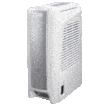Introduction
Prior to the the past decade, desiccant dehumidifiers had a pretty rough time of it. Reliability problems seemed to be ingrained into the technology and people who bought them on the promise of quieter operation, increased portability and low-temperature working were often left disappointed, before returning to the tried and tested refrigerant dehumidifier technology. However, technological and manufacturing advances shown in recent models (we shall come to them) have completely bucked this trend and as of today they are at least as popular as refrigerant models, if not more so.
How Do They Work?
Desiccant dehumidifiers work through use of desiccant material. Desiccant substances, such as the silica gel pouches found in boxes of electronics or clothes are so attractive to water (called hygroscopic) they literally strip moisture from the the air. In a dehumidifier the desiccant material is held on a rotating disc. One part of the disc has the air from the room blown on to it, which extracts the moisture from it. The disc then rotates until it is exposed to a hot blast of air, which drives off the moisture, where it is collected in the tank below or in the auto-drain pipe. This reactivates the desiccant material and the process cycles continuously in this manner.
Should You Buy One?
The main benefits of a desiccant dehumidifier stem from it not requiring a compressor, this means a lot less weight (half the weight of refrigerants) and a lot less noise. As a by-product, because they do not work through refrigeration it means they’re much more efficient at low temperatures, making them more suitable for sheds, boats and other places that are typically below room temperature. You shouldn’t rule out refrigerant dehumidifiers just yet, as there are still benefits – check the link for our page on them.
Desiccant Positives
- Very quiet – the only thing you may hear is the fan, however on ‘quiet’ settings this is barely audible
- Lightweight – around half the weight of refrigerant models
- Can operate efficiently at low temperatures, great for rooms that are below normal room temperatures
- They heat the room as a by-product (could be a positive or negative)
Desiccant Negatives
- Reliability – unlikely to last as long as refrigerants, which usually last decades
- Not as effective for large or poorly insulated spaces
Best Desiccant Dehumidifier Reviews
EcoAir DD122FW Classic Review
 The EcoAir DD122FW Classic Mk5 is the nation’s and our favourite desiccant dehumidifier, topping all sales charts. It is highly effective, portable, easy to use and has a great range of quiet and efficient modes. As an added bonus it carries a silver filter and ioniser. Read EcoAir DD122FW Classic Review.
The EcoAir DD122FW Classic Mk5 is the nation’s and our favourite desiccant dehumidifier, topping all sales charts. It is highly effective, portable, easy to use and has a great range of quiet and efficient modes. As an added bonus it carries a silver filter and ioniser. Read EcoAir DD122FW Classic Review.
DeLonghi DNC65 Review
 The Delonghi DNC65 is the lightest full-sized dehumidifier available at just 5.5kg. It’s DeLonghi’s only desiccant model, however is relatively powerful and easy to use. To top it off it comes with a two-year warranty, ioniser and bacterial filter. Read DeLonghi DNC65 Review.
The Delonghi DNC65 is the lightest full-sized dehumidifier available at just 5.5kg. It’s DeLonghi’s only desiccant model, however is relatively powerful and easy to use. To top it off it comes with a two-year warranty, ioniser and bacterial filter. Read DeLonghi DNC65 Review.
Meaco DD8L Review
 The Meaco DD8L is a very close second to the EcoAir DD122FW and we feel this very small unit deserves more credit, as it actually has a higher advertised extraction rate than the EcoAir model. Whether in practice this makes any difference is another matter… Read Meaco DD8L review.
The Meaco DD8L is a very close second to the EcoAir DD122FW and we feel this very small unit deserves more credit, as it actually has a higher advertised extraction rate than the EcoAir model. Whether in practice this makes any difference is another matter… Read Meaco DD8L review.